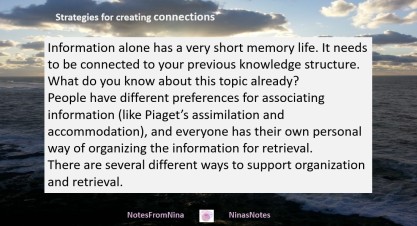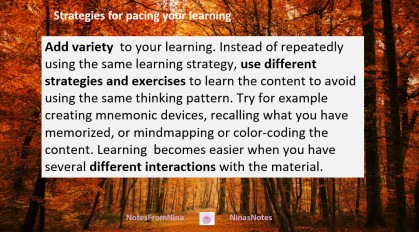Metacognitive skills are important for deeper learning. Simply put, metacognition is our knowledge of our own learning and cognitive processes, and also how to use those processes to help us learn better[1]. Therefore, knowing several learning strategies and being able to teach students how to use different strategies is essential for being a good teacher.

Discussing learning strategies with students is an important part of teaching!
Learning to learn is an important topic to cover throughout formal education. It shouldn’t be a subject of it’s own, but those learning skills must be embedded into everyday instruction. The funny thing is, that while we as teachers know about learning strategies, we don’t always apply that knowledge to our own learning. I have very funny discussions about this with my own students (teachers pursuing their M.Ed. degrees) when I get to remind them about the learning strategies they remind their own students about. 🙂 I think we all just need reminders of how to best help ourselves to learn different things. The chosen learning strategy must match with the learning task! That’s why we need to know many different strategies!

Most deep learning processes benefit from using several different learning strategies!
Helping students to become self-sufficient and autonomous learners is a crucially important part of contemporary education. We cannot think that learning would end with high school diploma or degree certificate, most workplaces today require ongoing learning engagement.
I have grouped the learning strategies on Nina’s Notes as the following:
- ways to pace your learning
- strategies to memorize and recall
- strategies to make connections, and
- strategies that aim for deeper learning
Memorization strategies work quite similarly as learning categories on the first level of Bloom’s taxonomy: recognizing and recalling [2]. Therefore I am seldom recommending flashcards as a primary learning strategy – they detach the concept from the context. However, if you really need to recognize and recall something, then very focused use of flashcards may be useful. Please do remember to continue your learning from remembering to understanding, applying and analyzing!

Very focused use of flashcards may be helpful in certain situations. Remember to practice recalling, too!
While discussing and using different learning strategies it is important to remember the difference of perceving learning as a process and learning as a product.
Learning as a product refers to meeting the external objective(s) of instruction with a measurable change in behavior. This view emphasizes the importance of instruction and information delivery. Students are the object of instruction. Their choices and learner agency are very limited.
Learning as a process refers to the internal development caused by acquiring new information and elaborating one’s own understanding of using it. There is a triadic This view emphasizes learners’ active engagement in their own learning process and making sense of the content. Students are subjects of their own learning. They have choices and learner agency is supported in the learning environment.
I hope the Learning Strategies – series are useful for you and your students!
🙂
Nina
[1] Ormrod, J. E. (1999). Human learning: Principles, theories, and educational applications. 3rd. ed. Englewood Cliffs, NJ: Merrill Publishing Co.
[2] Krathwohl, D. R., & Anderson, L. W. (2009). A taxonomy for learning, teaching, and assessing: A revision of Bloom’s taxonomy of educational objectives. Longman.





